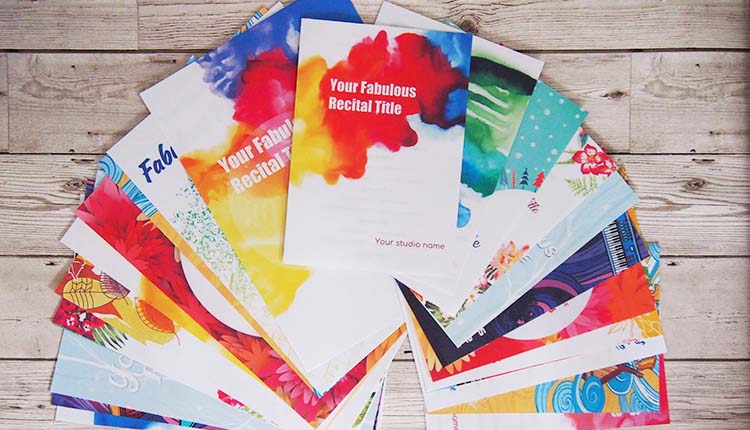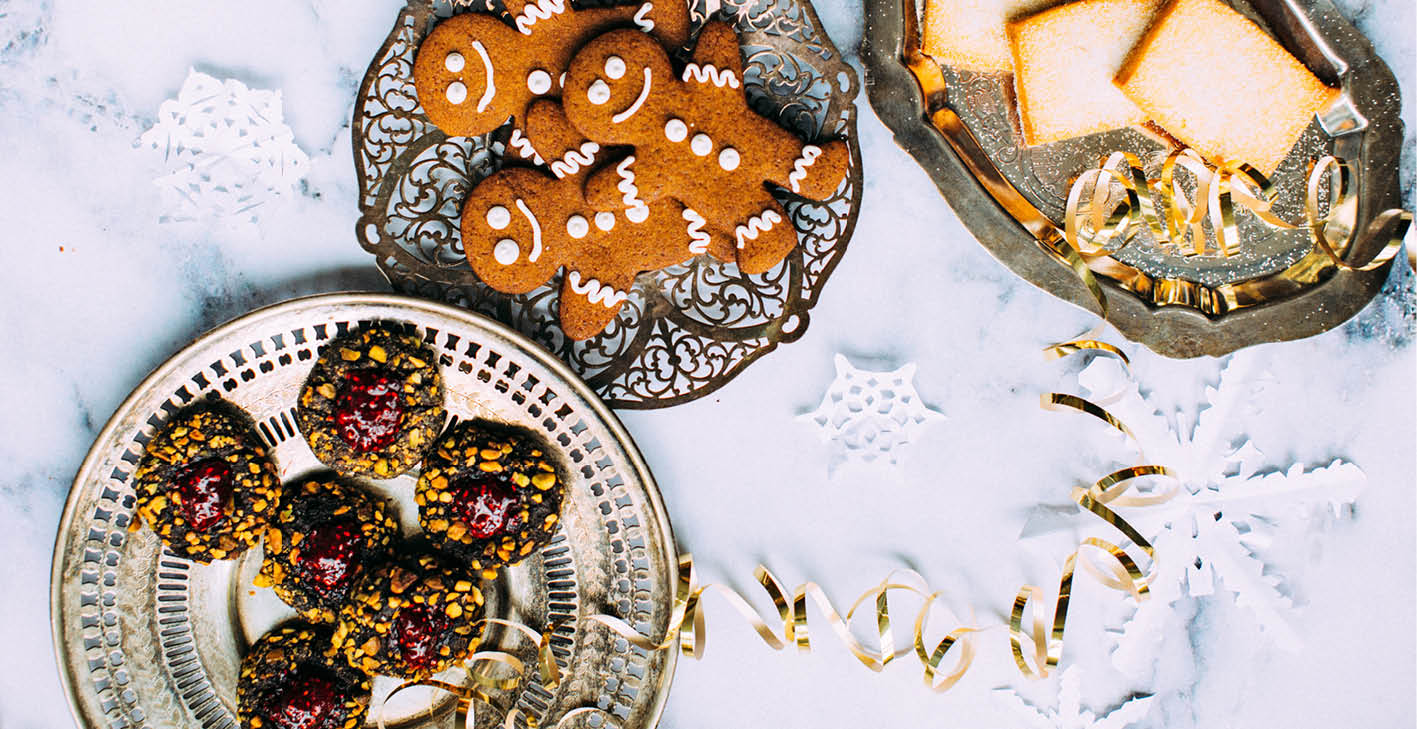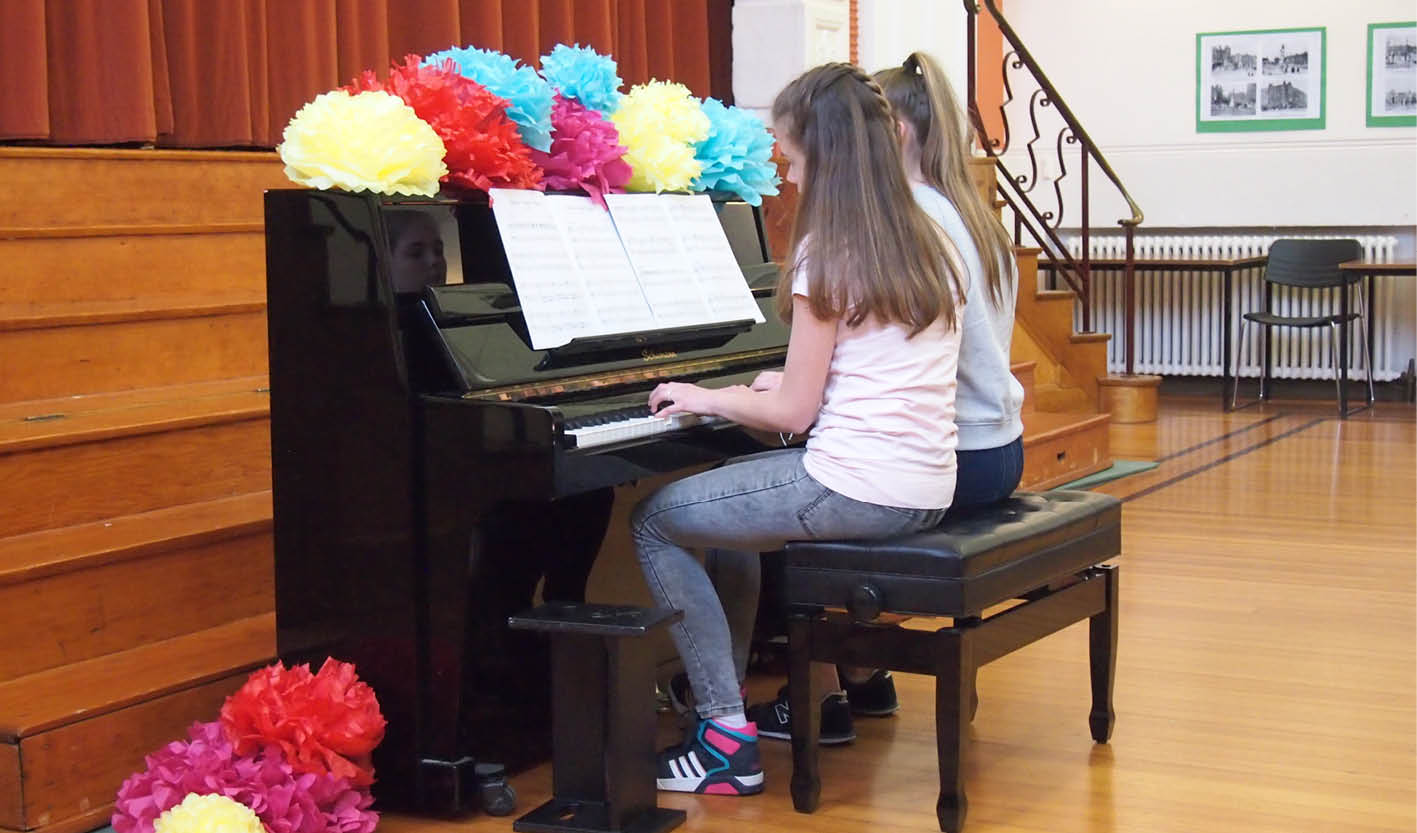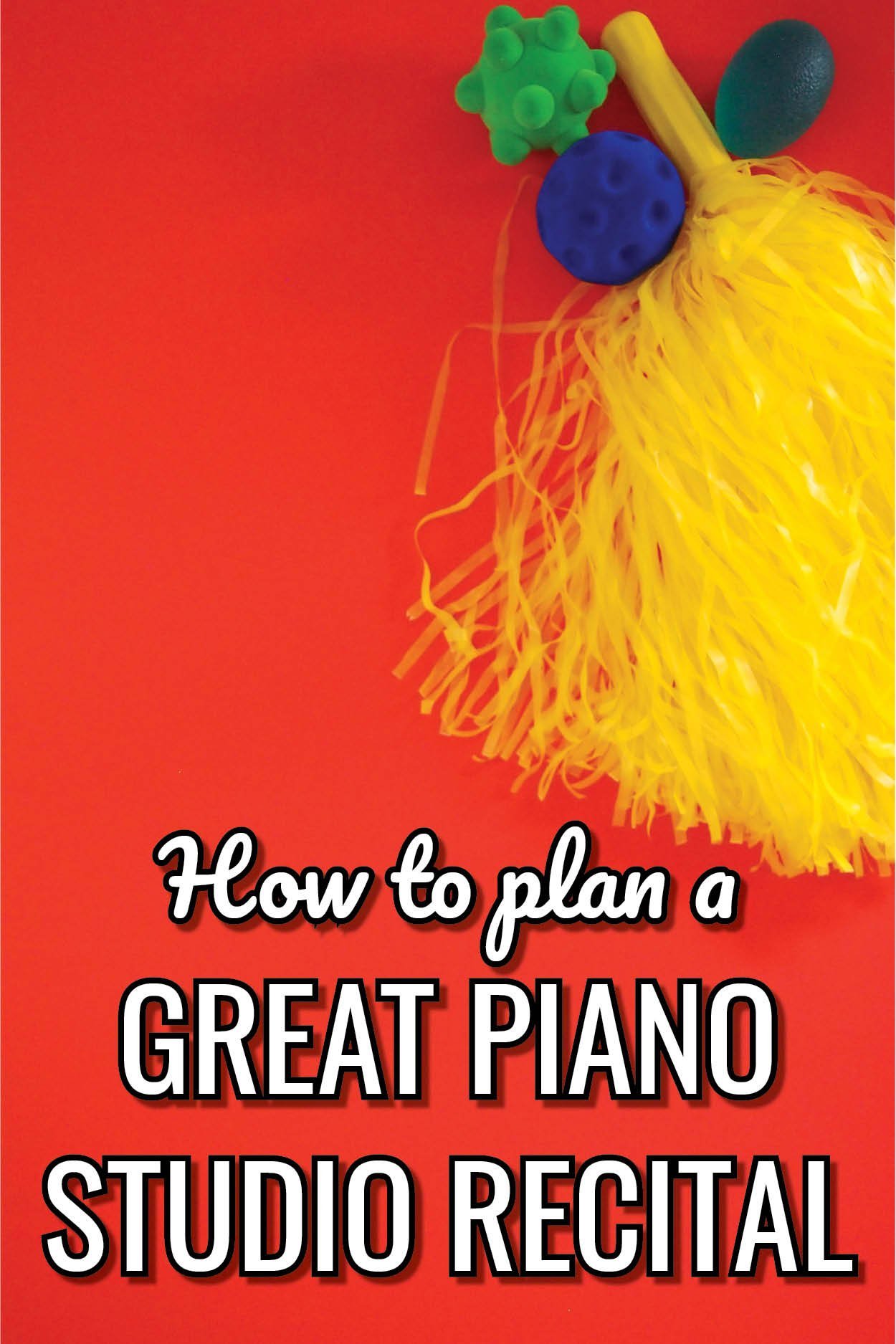This post about the ultimate piano recital plan was originally published in November 2018 and updated in March 2020.
Putting together a piano recital for your students is a fantastic way to give them a performance opportunity and celebrate all the progress they’re making.
But it’s not easy! There are lots of moving parts and so many things to remember.

Let me take you step-by-step through the entire process with this piano recital plan so that you know you have all of your bases covered.
3-6 Months Before the Recital
Recital Venue
The first thing to think about when planning a piano recital is your recital venue. The options will be different depending on where you are in the world, but here are some of the most common recital venues:
- Churches
- School halls
- Community centres
- Nursing/care homes
It’s good to get into the habit of making a note to yourself whenever you see a piano when you’re out and about and to enquire about hiring the space.

If you’re not having any luck finding a good space with a piano that you can afford, you have 2 options. You can hire a piano, but this is often expensive. The more feasible option is normally to bring a digital piano to your venue.
You can also use your home studio as a recital space if it’s big enough.
I do my mid-year concert at my home studio. I have enough space for 30 people if I move out all the furniture, and I invested in IKEA chairs a while back for this annual occasion. This means I can have 10 kids in each recital, along with their parents, and it makes for a lovely low-pressure performance environment every January.
Recital Date
No matter where your recital will be held, you’ll want to book the date at least 3 months before so you’re sure it’s available.
If you have a few dates to choose from and you’re not sure which would be best, email your studio parents. Just make sure to note that you know you probably can’t suit everyone (you really can’t!) but that you’ll go with the majority.
When you have your date tell your studio parents to mark it in their diaries and put a poster up prominently in your studio, so they have a constant reminder.
2-3 Months Before the Recital
Themes
You don’t have to have a theme. Really, you don’t.
But if you are going to theme your recital, now is the time to start planning it. Some examples of themes for your piano recital:
This is just the tip of the iceberg. Basically, anything you might do for a kid’s party would be a good theme.
Confirm Participation
In, or out. Your students and parents need to decide an absolute minimum of 2 months before the big day.
Email around and ask everyone to let you know before a certain day whether their child will be performing. Make sure to give them a deadline to respond – about a week should be sufficient.

Remember that deadline you set? Not everyone will meet it.
When the day rolls around that they were supposed to respond by, send a text to those that haven’t gotten back to you. Everyone needs to give you a yes or a no.

Subscribe to updates and get the Recital Readiness Checklist
Enter your details to subscribe to the newsletter for piano teachers with information, tips and offers.
I hate spam as much as you do! I'll only send you information that's directly relevant to music teachers and you can unsubscribe at any time.
6 Weeks Before the Piano Recital
Piece Selection
If your students are going to be learning a brand-new piece especially for your recital, then you need to move this waaaay back. Six weeks is not enough time to bring a new piece up to performance level.
However, my students do not learn new pieces for the piano recital. I see the recital as a chance to show off what they’ve learned this year or this semester.
At this stage, we’ll be picking one or two of their favourite pieces that they’ve learnt recently. From there it’s just a case of refreshing the piece and bringing it back up to performance level.
We choose their piano recital piece together at their lesson and I make a note of each as we go.
If you’re going to perform yourself, now is the time to pick your own piece and get working on it too. 😀
Performance Practice
Once we know what piece they’ll be playing, they need to get practising!

Every week from here until the recital, I have my students do a full performance run-through at their lesson.
I sit on the couch in my studio, pretending to be in the audience. The student will walk up nicely to the piano and:
- Place their book on the stand.
- Fix the bench and sit down.
- Place their hands on the keys, take a breath and hear the beginning of their piece in their head.
- Play the piece without stopping or “fixing” mistakes.
- Lift their hands gracefully off the keys and place them in their lap.
- Pick up the book, take a bow and walk back to their seat.
My students will do this routine at every lesson for 6 weeks, and will also practise it at our group performance workshop (more on this below). I want them to be really confident with all the details so that they can relax a bit and enjoy their performance.
Want more tips about preparing your students for a performance? Visit the Recitals section of my Studio Business hub page.
Begin the Piano Recital Program
As my students select their pieces, I’m creating the piano recital program.

If creating the program is the part that stresses you out, then I’ve got you covered. Download a free recital template, save a copy of the file to your computer, and watch the video below to learn how to edit the template.
Vibrant Music Teaching members can access a complete set of programs and poster templates in the VMT library.
Not a member? You can still download one free recital template. While you’re at it, learn more about the awesome benefits exclusive to VMT members!
While you’re creating your program you’re going to come up with a question I hear from teachers a lot: What order should I put students in?
Of course, there’s no “wrong” way to do it. But here’s my process:
- Set the first performer. Choose someone who’s not going to be phased – usually, a young student who I know won’t be nervous and is playing a duet with me.
- Set the last performer. This should be the most impressive piece and allow one of my more advanced students to shine.
- Mix up the rest. Avoid putting siblings back-to-back, or students of a similar age who are at widely different levels. Basically, avoid any situations where there could be a negative comparison between the students.
I know many teachers would go from beginner to advanced but I have 2 problems with this:
Firstly, I think it’s too competitive and piano recitals should just be about celebrating and enjoying music.
Secondly, it makes for a very boring concert! It’s not fun to sit through a bunch of beginner pieces in a row, no matter how fabulous they might be for their level.
3 Weeks Before the Recital
Piano Recital Rehearsal
About 3 weeks before my recital day is when I have my performance workshop in my home studio. All the students come to, and we do a sort of dress rehearsal of their pieces.
The focus of this trial run is not on the pieces themselves (although of course, I’m taking note of any stumbles.) It’s on the performance etiquette.
The checklist for this is the same as my students have been practising in our lessons.
I do a “what not to do” demonstration of a performance at the start and have them correct all of my mistakes. Make this as exaggerated and ridiculous as possible for hilarity’s sake.
Then, we draw names one by one from a hat, and that student goes up to perform. The other students’ job, as the audience, is to take note of these elements that the performer forgot.
Refreshments
If you’re going to provide refreshments afterwards, now is the time to think about it.
If your recital venue allows refreshments to be served, I think it’s nice to provide something so that people have a reason to stick around and chat after your piano studio recital. It doesn’t need to be fancy, though.

I simply opt for biscuits (cookies to my friends in the US) and juices. The kiddos could use a jolt of sugar after a performance, and it gives me a chance to go around and tell each and every one how fantastic they are.
If you want to do fancier refreshments, I highly suggest asking parents to volunteer. You don’t want to be baking like crazy at the last minute.
Decorations
Depending on your recital venue, you may want to dress it up a bit with some decorations.
Again, keep this simple. Go for something that makes a big impact with a minimum budget and effort. I find giant paper flowers (super easy to make) or balloons work best.

Just keep in mind the size of your recital space. Something that would look great in your living room can just disappear in a big hall.
Double-check Program
Remember: Vibrant Music Teaching members can access a complete set of programs and poster templates in the VMT library.
Not a member? You can still download one free recital template.
Family Attendance, Posters & Tickets
At the three-week mark, I like to check in with my piano studio families to see how many will be attending.
For my mid-year concert, I have to monitor this very carefully since it’s in my home studio.
For the Spring concert, they can bring as many guests as they like – the more the merrier! But I do need to have an idea of the number of chairs to put out. I don’t want there to be a bunch of empty seats. (This doesn’t look great in photos.)
If you’re going to be selling tickets, you’ll want to move this item back on your checklist.
Whether you’re selling tickets or not, it’s a good idea to put up a poster in your studio to advertise the event and get people excited about it. Vibrant Music Teaching members can access editable poster templates in the VMT library to match your programs.

Subscribe to updates and get the Recital Readiness Checklist
Enter your details to subscribe to the newsletter for piano teachers with information, tips and offers.
I hate spam as much as you do! I'll only send you information that's directly relevant to music teachers and you can unsubscribe at any time.
Week of the Piano Recital
Confirm Venue
Woohoo! It’s the week of your piano studio recital! All the hard work is going to be worth it, I promise. 😊
It’s a good idea to just call up your venue now and double-triple-quadruple check that your space is reserved. Just in case.
Print Programs
I wait until the latest possible day to print my programs, without cutting it too fine.

I like to print mine 3 days before the recital day. This gives me enough time to go refill my ink or buy more card if I need it, but it’s close enough to the day that everything is definitely finalised.
Your Speech
Public speaking is apparently one of the most common phobias.
I’m not quite at phobia level, but I can’t say I revel in it.
If you’re someone who gets very nervous for this part of your recital, I can at least assure you it does get easier. The main thing is to keep it simple, as I explain in my podcast about crafting the perfect recital speech.
At the minimum, tell the audience:
- To only step out during an applause, to avoid distracting performers
- Where the bathrooms are and where the fire exits are
- Any other essentials about running order, etc.
- That you’re excited they’re here and to share music with them!
Don’t feel you have to give some big formal speech. (Although, you can if you want to!)
And if you’re very, very nervous about it — ask a student to do it instead.
Set Up a Playlist
Having some kid-friendly music playing as your students arrive and get settled is a lovely touch and sends the message that this day is for them.
The wonderful Sara Campbell has made this super easy by sharing her Spotify playlist the last couple of years. So, we don’t even have to find out the latest cool kids’ songs and listen to make sure the language is all appropriate. Thank you, Sara!
Make a Packing List
Don’t you hate that feeling when you’re on the way to the airport and just convinced that you’ve forgotten something? You spend the whole car journey running through your mental checklist again, and again…and again.
I get that with recitals too. So, I like to make a checklist a few days before of everything that I need to bring with me, like:
- Programs
- Posters
- Tape
- Scissors
- Decorations
- Speaker
- Camera
- Tripod
- Piano benches
- Teacher duet parts
I won’t bore you anymore with that list, but you get the idea. Make this list in advance of recital day. It’s worth it for the peace of mind.
Is my piano recital plan complete?
I really hope this checklist is helpful as you get ready for your next recital.
Let me know if I missed anything, or if any of these were a surprise to you, in the comments below.

Thanks so much for all this information. I figured out some of it thought trial and error over the years but you presented new ideas as well and good reasons for doing some of the ideas. I will use some of these ideas. I never thought of bringing a keyboard to a place to have a recital. It is very difficult to find a recital hall in CA
You’re welcome Linda! I think with the quality of some digital pianos these days it’s a very viable option. Many gigging musicians are carrying around their own instrument so if it’s good enough for them…:)
Very thorough list — thank you!!!
Thanks, Nicola! Very good information, and summarized nicely and easy to use. I totally agree with how you mix up the program. My parents tell me they actually look forward to our studio recitals, and I’m so glad! I think it’s largely because of the time I spend sequencing their pieces. Avoid lulls! Too many slow flowing ballads in a row, for instance. Even make the keys of the pieces ‘”rise” – C Major to D Major, to G Major and back to C Major. (Makes a difference, assuming that children don’t take long, slow walks back and forth to the piano.) One other thing I do, since we have two halves and an intermission, is that I try to find students for 4 “feature” spots on our programs–I call it “openers and closers” informally to myself. I choose the opening and closing piece of each part of the program very carefully. I think the last piece before the intermission is a special spot, too. It follows then, that after intermission, you’d like to get the room energized with a piece (or duet) that comes off with a bang. This is the 2nd “opener”. Everyone knows the rest. Younger students can definitely play in these spots, even though they are not “the older students”. Generally, the last piece is the most impressive, but sometimes I use a piano ensemble last, or pull in a special guest and I accompany them (cellist or vocalist). This works well in years when you’ve not got anyone particularly up to the challenge of “closing the recital with a big piece”, or no high schoolers playing longer works. The main thing is that people leave your recitals with smiles on their faces. Keeping them to a good length and well-paced is the ticket, in my book.
Thanks for your thoughts Janelle. I definitely agree with you about bookending each section with strong/interesting/exciting pieces. 🙂
It’s a great source of knowledge; I think it will be helpful for lot of people who are looking for learning more about the piano recital plan. Thank you very much for sharing this article.
So, my first recital was yesterday, and I wanted to come back here and share that this list along with other resources on this website have helped me A LOT in preparing for the event. I used the list extensively as a guide and it was very reassuring to have a tried-and-true plan to follow along. Seven of my students performed, ages 6-11, and they all played well with very minor fumbles. I think this was thanks to the fact that we started working on the pieces 6 weeks before the concert, so they had plenty of repetitions. We also practiced playing with distractions with the distractions cards from VMT, which probably also contributed. Everyone had fun, parents were happy and proud, so overall – a success. Thank you very much for sharing all this knowledge!
That’s wonderful, Tal! Congratulations and thank you so much for sharing!
Thank you for sharing this information.
Do you introduce each child and the piece they will be playing? Do you have them introduce themselves or just as in a more formal concert have each child just come up and play with the program speaking for itself?
I let the program speak for itself. If a student doesn’t realise they’re up next, I just call their name as a reminder.